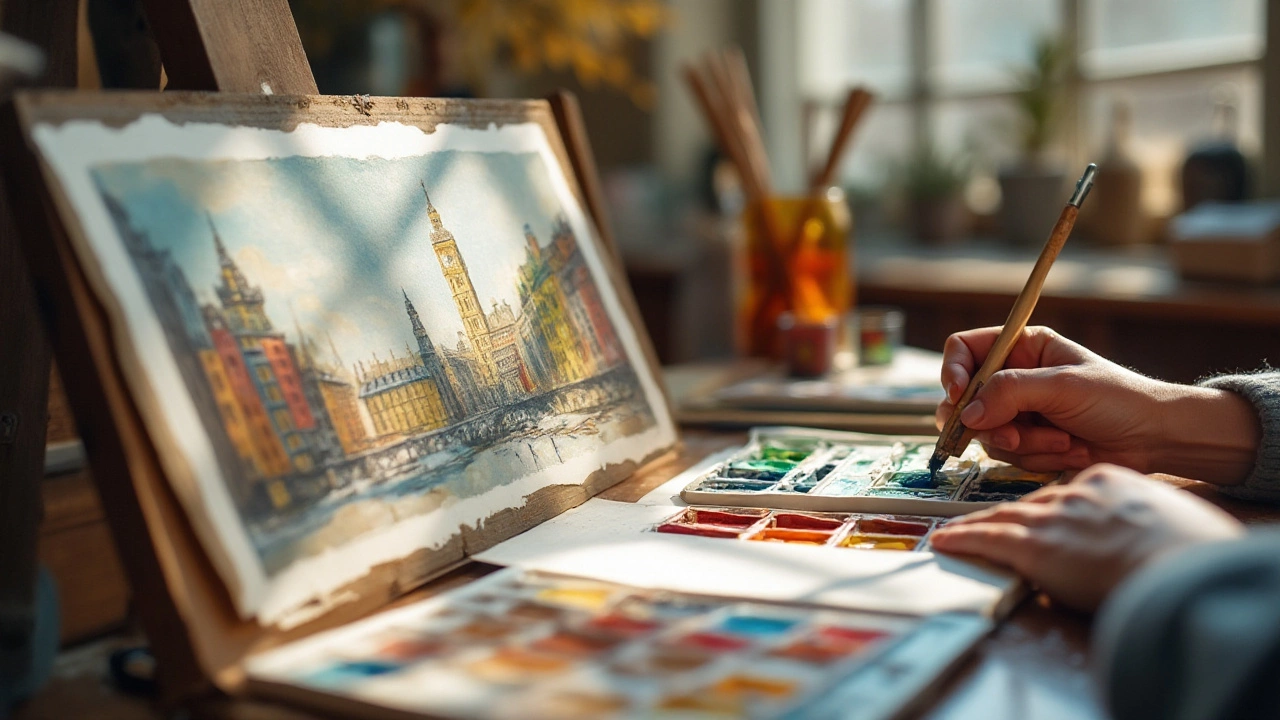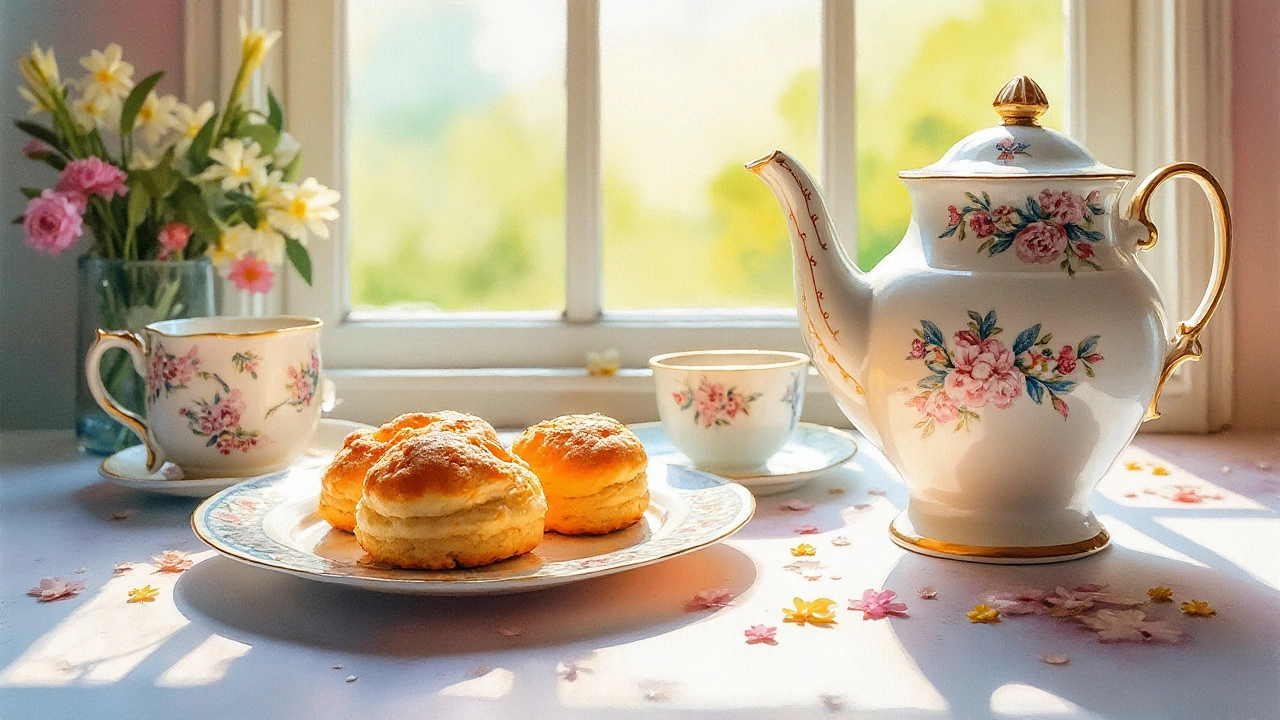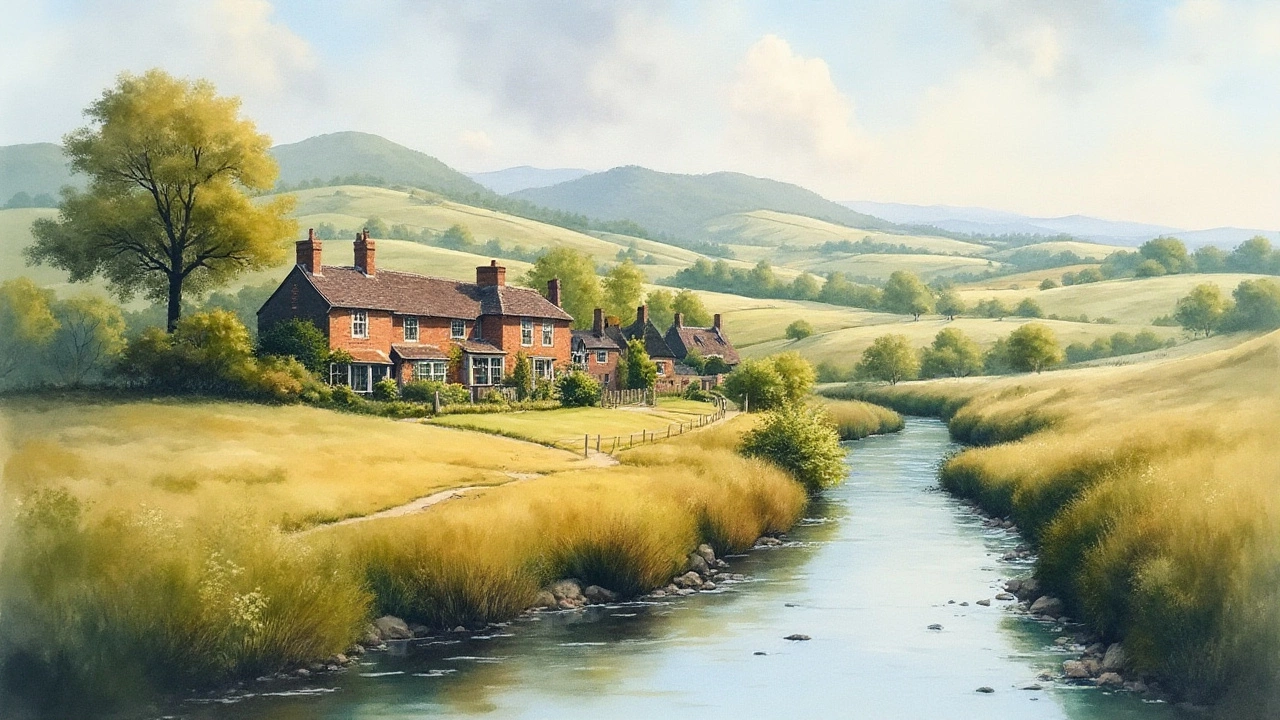Watercolor painting has long been admired for its translucent beauty and ethereal qualities. However, it is often acknowledged as one of the most challenging mediums for artists to master. Its fluidity, while part of its charm, contributes to its difficulty as well. There's something uniquely unforgiving about watercolor; once the paint hits the paper, it can be nearly impossible to alter.
This article delves into why watercolor is so complex, offering insights into how water and pigment interact, essential techniques newcomers should embrace, and common pitfalls to avoid. Both beginners and seasoned artists can gain valuable knowledge and tips to help them craft their watercolor masterpieces with greater confidence and joy.
- The Unforgiving Nature of Watercolors
- Understanding Water and Pigment Interaction
- Essential Techniques for Beginners
- Common Mistakes to Avoid
- Tips for Mastery
- The Joy of Watercolor
The Unforgiving Nature of Watercolors
Watercolors possess a certain mystery, a behavior that often challenges artists seeking to master them. Unlike other mediums, where mistakes can be simply painted over or corrected, watercolors require one to be both deliberate and spontaneous in their approach. Once the vibrant, translucent pigment meets the paper, it immediately stakes its claim, making reversal nearly impossible. This very attribute is what both enthralls and daunts those who attempt to harness its power.
The nature of watercolor can be unpredictable, as each brushstroke is a dance with destiny. The medium demands that artists plan carefully, visualize each layer, and anticipate how water and pigment will interact. The artist must embrace the unexpected, as watercolor painting is a study in the balance between intention and chance. It's a bit like trying to harness the wind—exhilarating but never totally in your control. Watercolor has a memory and transparency, and that means each stroke is indelible once dry. You cannot hide errors as easily as you can with oil or acrylic paints. There's a wonderful quote by the famous artist John Singer Sargent, "Watercolor is making the best of an emergency." This sums up the need to adapt and to move forward, embracing the imperfections that come along the way.
Moreover, the choice of paper plays a pivotal role in the outcome of a watercolor painting. The texture, absorbency, and quality of the paper all directly influence the flow and appearance of the paint. Cold-pressed, hot-pressed, and rough papers all have distinct characteristics, and selecting the right one is crucial to achieving the desired effect. Artists often find themselves conducting little tests to understand how their chosen paper interacts with water and pigment. In watercolor, paper isn't just a surface—it's an active participant in the creative process.
Indeed, mastering the medium requires a paradoxical blend of careful planning and willingness to embrace serendipity. Each stroke, each wash requires artists to be thinkers and dreamers at the same time—to plan meticulously and surrender gracefully to the unpredictability. Artists learn to love the imperfections, the accidental beauty that comes from letting go of control. Once an artist accepts this, watercolor's unforgiving nature transforms into an exhilarating challenge, inspiring creativity and a deep sense of achievement. The medium becomes a collaborator in the creation, guiding the artist toward unexpected discoveries.
Understanding Water and Pigment Interaction
At the heart of watercolor painting lies a dynamic dance between water and pigment, a relationship both intricate and fascinating. Initially, one might underestimate the complexity involved, seeing simply the act of applying paint to paper. However, even slight variations in water quantity or the angle of the brush can significantly influence the outcome. Watercolor is all about finesse and balance, requiring an artist to continuously adjust and adapt their technique.
The way water interacts with pigments is pivotal. Water serves not only as a vehicle to transfer color but also determines the flow and spread of pigments on paper. It's crucial to control the water-to-pigment ratio to achieve the desired effect. More water results in a lighter, more transparent color, while less water offers a denser and more saturated hue. Moreover, the type of paper used can impact absorption and how pigments settle, making practice and experience vital components in mastering this medium.
“Watercolor is like golf. You can become a competent craftsman but to become a master is to cross paths with the unpredictable.” – Edgar Whitney, a noted watercolorist.
Beyond water ratio, the interaction varies with the type of pigment. Some pigments are naturally heavier, settling into the texture of cold-pressed paper and creating granulation effects that are often sought-after. Such nuance brings texture and depth to a painting, but it requires an understanding of the pigments being used. Knowing which pigments are staining and which can be lifted can make the difference between a muddled mess and a work of art.
Water itself has its character, influenced by humidity and temperature, which might sound trivial but plays a critical role in watercolor. On humid days, drying times increase, leading to extended periods for pigments to flow and mingle. Conversely, a dry environment accelerates drying, demanding swift and deliberate action. An artist must learn to adapt to these changing conditions. Mastering this balance requires patience and the willingness to embrace happy accidents, as unexpected interactions can lead to beautiful results.
An interesting aspect of this medium is the capability to play with gravity, using techniques like wet-on-wet and wet-on-dry to create various effects. In wet-on-wet, the paper is first moistened, and the pigment blooms when applied, ideal for soft washes or cloud-like effects. Wet-on-dry, on the other hand, can yield crisp lines and shapes. Artists exploit these variations to bring life and movement into their paintings.
Overall, understanding how water and pigment interact is akin to learning a language; it opens up a wealth of expression and creativity once understood. Each painting is an opportunity to better grasp this dynamic relationship, highlighting the medium’s potential. With practice, artists can predict how the paint will behave, transforming initial frustration into a dance that is both deliberate and spontaneous, indicative of a harmonious unity between the artist and the art form.

Essential Techniques for Beginners
Diving into the world of watercolor painting can feel like walking a tightrope, especially if you've never held a brush before. The good news is, with a little patience and practice, you'll soon be painting like a pro. One of the most important things to keep in mind is that watercolor paints behave differently than other mediums such as oil or acrylic. Unlike these, watercolor is transparent by nature, meaning you'll be working with light washes to build up your painting gradually. This can be tricky for beginners who are used to layering paint thickly, but this transparency is what gives watercolor its charm and glow. It's essential to approach this medium with an open mind and willingness to experiment, as each brushstroke has the potential to transform your artwork in unexpected ways.
A critical step for beginners is to invest time in understanding how water and pigment interact. Water control is perhaps the trickiest aspect of watercolor, as it determines the flow and depth of the colors. Start by experimenting with different ratios of water to paint. You'll find that more water results in lighter, more translucent colors, whereas less water creates dense, vibrant hues. Don't be afraid to make mistakes as you explore; each error is a learning opportunity that brings you closer to mastering the medium. As artist Edgar Whitney once said,
"Watercolor is like life. Better get it right the first time – you don't get a second chance!"
For those just starting out, mastering basic techniques such as wet-on-wet and wet-on-dry can be incredibly helpful. The wet-on-wet technique involves applying wet paint onto a wet surface, resulting in smooth, blurred effects ideal for painting skies, water, and reflections. Wet-on-dry, on the other hand, involves applying wet paint to a dry surface, giving you more control and the ability to create sharper details. Practicing these techniques will enhance your skill set and help you tackle various subjects with ease. You'll quickly notice that both approaches offer unique textures and effects, allowing you to choose the best method for the outcome you wish to achieve.
Other essential skills include learning how to use brushes and paper effectively. There are numerous brush types, each designed for different tasks. Round brushes are versatile and perfect for creating broad strokes or fine lines, while flat brushes are great for covering large areas or achieving precise edges. Choosing the right paper is equally vital. Opt for watercolor paper with a good weight and texture to prevent warping and absorb the paint properly. Cold-pressed paper is often recommended for beginners due to its forgiving texture, which works well for a variety of techniques. Remember, the quality of your materials can influence the final result of your painting significantly.
Don't forget to explore color mixing and design your own palette. Mixing watercolors offers endless possibilities, and creating your signature palette can add a personal touch to your paintings. Start with a few primary colors and mix them to understand how they interact. As you grow as an artist, continue adding new colors to your repertoire. Painting is not just about replicating what you see; it's also about expressing how you feel. Paying attention to how different colors convey different moods and emotions will deepen the impact of your work. This awareness, when combined with technical skill, can transform your watercolor journey into a fulfilling artistic endeavor.
To wrap up, remember that patience and practice are key to success in watercolor painting. Art is a forever evolving journey, and every painting is a chance to grow and learn. Keep experimenting with new techniques, materials, and subjects, and soon enough, what used to feel difficult will become second nature. Embrace every brushstroke, and every splash of water – they're all part of the beautiful, unpredictable journey that is watercolor.
Common Mistakes to Avoid
When venturing into the mesmerizing world of watercolor, artists, beginners and experienced alike, might find themselves stumbling over a few recurring hurdles. One frequent misstep is underestimating the potential of water itself. This art form relies heavily on the delicate dance between pigment and water, making it crucial to control the water-to-paint ratio. Too much water can cause colors to bleed indiscriminately, while too little might make the paint difficult to manipulate, resulting in unwanted harsh lines. Many novices also overlook the importance of paper quality. Using improper paper can lead to buckling and uneven drying, which interferes with the painting process, discouraging many budding artists.
Another common mistake is to apply paint in a manner that's too quick and heavy-handed. Watercolor often requires a light touch, with patience being a close companion. Layering is a skill that requires practice and precision. Rushing this process means missing the subtle richness that builds as layers dry slowly, creating depth and vibrance. Painting over an area that's still wet can disturb the paper’s texture, creating muddied colors and tearing. This delicate balance makes patience not just a virtue, but a necessity in the realm of watercolor.
A misconception that plagues many is the belief that correction is impossible in watercolor. While it's true that the medium is less forgiving than others such as acrylic or oil, there are techniques to rectify mishaps. Lifting color, a method by which wet paint is gently dabbed with a clean, damp brush or sponge, can address errant blobs or too-dark areas. Practicing this technique in steps is crucial for beginners. Similarly, the use of masking fluid to preserve white spaces can be an invaluable tool, yet it needs to be employed cautiously to prevent damage to the paper.
"Watercolors are like love, there's a natural fluidity that can't be forced," said renowned artist Agnes Martin. Her words ring true as understanding and patience are key to both disciplines. The artistry lies in embracing imperfection and unpredictability.
Neglecting the final touches can tarnish the outcome as well. Whether it’s failing to properly mount the painting to prevent warping or skipping the light pencil sketches that guide composition, overlooking these details can hinder a painting's complete potential. Many artists find keeping an art diary helpful to track these small but mighty lessons. By noting down these experiences, artists can see progress in their techniques, understanding what works and what doesn't over time.

Tips for Mastery
Conquering the art of watercolor painting requires a well-balanced blend of technical skills, patience, and creativity. Start with the basics: understanding how water and pigment interact. This medium is famous for its fluidity, which can be both a blessing and a curse to unpracticed hands. It is crucial to experiment with water-to-paint ratios, practicing on scrap paper before diving into a full piece. This will give the artist a better sense of how paint will move across the page and how colors will change as the water evaporates.
One excellent technique for mastering watercolor is to consciously control the drying times. In essence, the paint behaves differently depending on the wetness of the paper. Wet-on-wet technique creates softer edges and is ideal when you aim for a dreamy, blended look. For finer details, wait for the painting to dry and use a different approach. Planning the painting in layers can be beneficial as well, building up from light to dark further adds depth and dimension. Judicious use of negative space can help, emphasizing the painting's subject without the need for over-accessorizing with details.
Art is vast and varying in styles; therefore, anchoring yourself in one technique might limit your growth. Always be on the lookout for new styles; embrace the boundless inspiration that daily life has to offer. Develop a habit of carrying a sketchbook around; as you travel through different environments, make quick sketches and annotations of scenes that inspire you. Emulating the work of others is a path traditional artists have long followed. Many find valuable insights in studying different masters' techniques, even attempting to replicate certain elements.
"The more I paint, the more I like everything." - Pierre Auguste Renoir
Quality tools do make a difference. Using a variety of paint brushes, such as round, flat, and fan, gives more control over detail work and broader strokes. Never underestimate the paper's quality; thicker, heavier paper can absorb more water, reducing the risk of crinkles and preserving the integrity of your work. Likewise, experimenting with different color palettes and paint brands, which offer varying pigment concentrations, expands the artistic horizons. Cleaning brushes thoroughly after each session also prolongs their life and preserves color integrity.
Engage with fellow artists, attending workshops and community meetings. Sharing knowledge and experiences can provide unique insights - others may have faced similar obstacles and found innovative solutions. Supplying constructive critiques creates opportunities to look at work with fresh eyes and helps hone unique styles. Beyond the technical aspects, developing specific habits is crucial to gradual improvement. Allocating dedicated painting time regularly can significantly enhance an individual's comfort with the medium, stimulating progress in an organic fashion.
Painting with watercolor requires embracing mistakes as part of the process. Despite meticulous planning, life boasts unpredictability, much like the way watercolors dance on the canvas. Instead of perfect symmetry, stumbles can become perfect opportunities for learning. Approach these challenges with an open mind and a sprinkle of humor. Each stroke and splatter comes with its individual lesson, fostering a deep appreciation for watercolor's unique unpredictability. This creative dance with water is where masterpieces are born.
The Joy of Watercolor
Amidst the challenges and complexities, there lies an undeniable joy in wielding a brush dipped in watercolor. It's an experience that transcends mere application of paint; it's a dance between control and freedom. When the unpredictable blend of water and pigment takes form, it can evoke an unforeseen beauty, leaving the artist to marvel at the marriage of intention and chance. This thrill of discovery is unique to watercolor, allowing artists to capture the fleeting essence of moments in ways other mediums may find elusive.
Creating with watercolor offers a sense of immediacy and connectivity with the medium that is deeply satisfying. The delicate washes and vibrant hues can express emotions and atmospheres, bringing to life the subtleties of daily scenes and wild landscapes alike. It's this capacity for both delicate precision and bold expression that makes watercolor painting a favorite for many artists worldwide. Several artists, including the renowned Winslow Homer, have extolled the virtues of painting with watercolor, emphasizing its ability to capture light and atmosphere in rapid, fluid strokes.
For many, watercolor painting is not just an artistic pursuit but a form of meditation. The act of focusing on the present, on the movement of the brush and the dance of colors across the paper, can be a form of mindfulness, offering a respite from the world's clamor. This meditative aspect can enhance one’s appreciation of the beauty in the everyday, teaching patience and acceptance of imperfections. As one artist candidly put it,
'Watercolors are more than just pigments and water; they are lessons in life and letting go.'It's this transformative potential, both for the artist and the observer, that makes watercolor so cherished.
Moreover, watercolor's versatility adds to its allure. Whether painting plein air, capturing a fleeting sunset, or in the studio exploring abstract forms, watercolors offer a fluid adaptability. They can be airy and subtle, or intense and moody, easily adapting to an artist's mood and intention. This flexibility is ideal for expressing a wide range of styles and subjects, from detailed botanical illustrations to loose and vibrant portraits. In this way, watercolor becomes a companion on every creative journey, always offering new ways to see and depict the world.
Furthermore, watercolors don't require extensive equipment or studio space, making them accessible for artists at any stage of their journey. A small tin of paints, a few brushes, and a pad of paper are all one needs to begin exploring the medium's endless possibilities. This simplicity in material can be liberating, freeing artists from the confines of complex setups and encouraging spontaneity and experimentation. Watercolor's portability allows it to travel with you, offering an ever-ready canvas for inspiration in every corner of the world.
For those venturing into the watercolor realm, it's not just about the finished piece but the process itself that is often the prize. The beauty lies in the unexpected outcomes, where every brushstroke is a leap of faith into the unknown. Each painting becomes a page in a personal diary of exploration, capturing not just the world around us but the emotions and experiences of the artist themselves. In this dance between the known and the serendipitous, the joy of watercolor lies waiting to be discovered by anyone willing to take up the brush.

